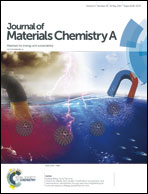Solution-processed black phosphorus/PCBM hybrid heterojunctions for solar cells†
Abstract
Inorganic–organic hybrid structures are promising candidates for the fabrication of solar cells owing to their easy preparation and the integrated advantages of both components. Black phosphorus (BP), an emerging two dimensional inorganic material, has recently attracted attention, particularly in the field of semiconducting devices, because of its intrinsic characteristics including a tunable bandgap, efficient charge transport and superior conducting property. However, its poor stability, uncontrollable morphology and high-density charge traps have largely limited its further development and engineering for efficient photovoltaic devices. Herein, we present two sheet-shape hybrid heterojunctions using BP/PCBM (PCBM = phenyl-C61-butyric acid methyl ester) prepared in a solution process and their performance in solar cells. The well-prepared hybrid heterojunctions (a layered stacking structure and a doping-weaving structure) with a uniform hexagonal shape exhibited favorable optical and thermal stabilities. More importantly, the average power conversion efficiency (PCE) of the solar cells reached 6.4% using the hybrid with the layered stacking structure and 8.0% for the hybrid with the doping-weaving structure. The present study is the first example of combining BP and PCBM to form heterojunctions for highly efficient solar cells, which may open up a promising route for photovoltaic research.


 Please wait while we load your content...
Please wait while we load your content...